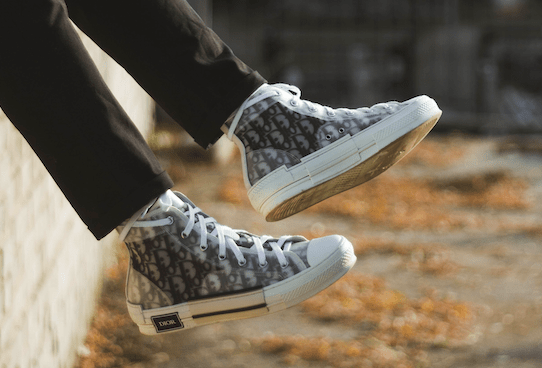From corsets to sneakers: Dior as a brand that revolutionised post-war fashion
Dior was founded in 1946 – a year after the end of the Second World War. Having been founded such a short time after fashion had been revolutionised by the war years, Dior had the job of transforming the monotone, mundane boiler-suit uniforms that were widely worn by females during wartime, into to something new and fresh. By producing the unexpected, Dior managed to achieve this.
As a post-war style that was modern and chic, Dior signposted their image on the French couturier’s runway in Paris on February 12th in 1947. The dresses were highly feminine, jackets were slim-fitted, hips and shoulders were padded, and skirts were below mid-calf in length. All of this differed from the masculine styles of womenswear during wartime. After such a devastating period of war, Dior opened a door to colour, femininity and class. So much so, Editor-in-Chief of Harper’s Bazaar, Carmel Snow, claimed Christian Dior “had a revolutionary new look”.
Creating a series of clothes that were nostalgic to the time before war allowed people to forget about the hardships that they had experienced. The runway was labelled the ‘New Look’, and it was widely flaunted by stylish women like Princess Margaret and famous actress, Marlene Dietrich. After the successful drop of new seasonal clothing, Dior’s fashion products made up 75% of Paris fashion exports by 1949.
Some feminists were astounded that the new designs involved regressive corsets
It was not an easy road to success for Dior as some people struggled to understand why so much money was being spent on making clothes while others struggled to make ends meet down to the economic ramifications of the war. 30,000 men, known as the League of Broke Husbands, were angry about the waste and cost of all the fabric needed to make Dior’s designs, especially coming out of the period of endless rationing of clothes.
As Dior emerged in the years following a period when women had been heavily involved in the wartime effort and wore clothing that reflected the new functional need for practicality, some feminists were astounded that the new designs involved regressive corsets. Despite these criticisms, the ‘New Look’ was and still is, a huge reference point of how a brand can completely transform their reputation and bring about changes to the fashion industry no matter the time. Raf Simons revisited the ‘New Look’ in 2012 and brought back the appearance of self-respected, expressive and flourishing looks, which brought Dior back into the fast-paced fashion world.
The death of Christian Dior in 1957 meant that the fashion house struggled with uncertainty and fear over the future. They wanted to close off all exports and stop retailing but eventually decided they couldn’t just drop everything that they had worked towards in the post-war period. Despite the loss of their founder and main designer, Dior became more of a household name as Christian Dior made the cover of ‘TIME’ magazine in 1957, and eulogies were written from other fashion companies. He has been widely remembered as a fashion genius and was regarded as one of the greatest designers of the time.
Dior has engaged with the streetwear season
Despite the death of the legendary designer, Dior still remains highly relevant, hence the ‘Christian Dior: Designer of Dreams’ exhibition in the Victoria and Albert Museum in London in 2019. After Dior’s new Creative Director Kim Jones became part of the brand in 2018, Dior came to prominence for its menswear. With an emphasis on athleisure, Dior began to move away from the traditional designs it had showcased since the 1950s.
While undergoing the rapid change from being known primarily for womenswear to now being heavily associated with menswear and streetwear, Dior has still kept to tradition by plastering the iconic monogram on most, if not every, new piece. Brands such as Burberry, Balenciaga and Fendi have used the same method. Dior has engaged with the streetwear season and perhaps even gone above and beyond its competitors in what the brand has achieved. A highly popular element of streetwear is sneakers and Dior managed to keep up with competitors by releasing the sportswear-inspired B24 and the Chuck Taylor-inspired B23 collaboration.
Dior’s new season harnessed by Kim Jones has been appreciated by both men and women, demonstrating how Dior has gone from being a brand made solely for women to an internationally renowned unisex clothing and accessory brand.

Comments